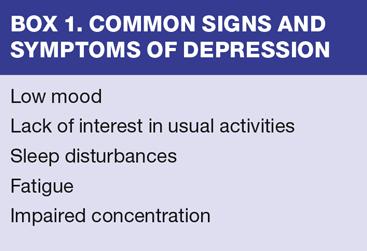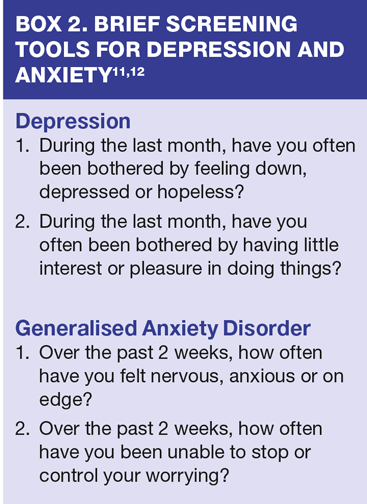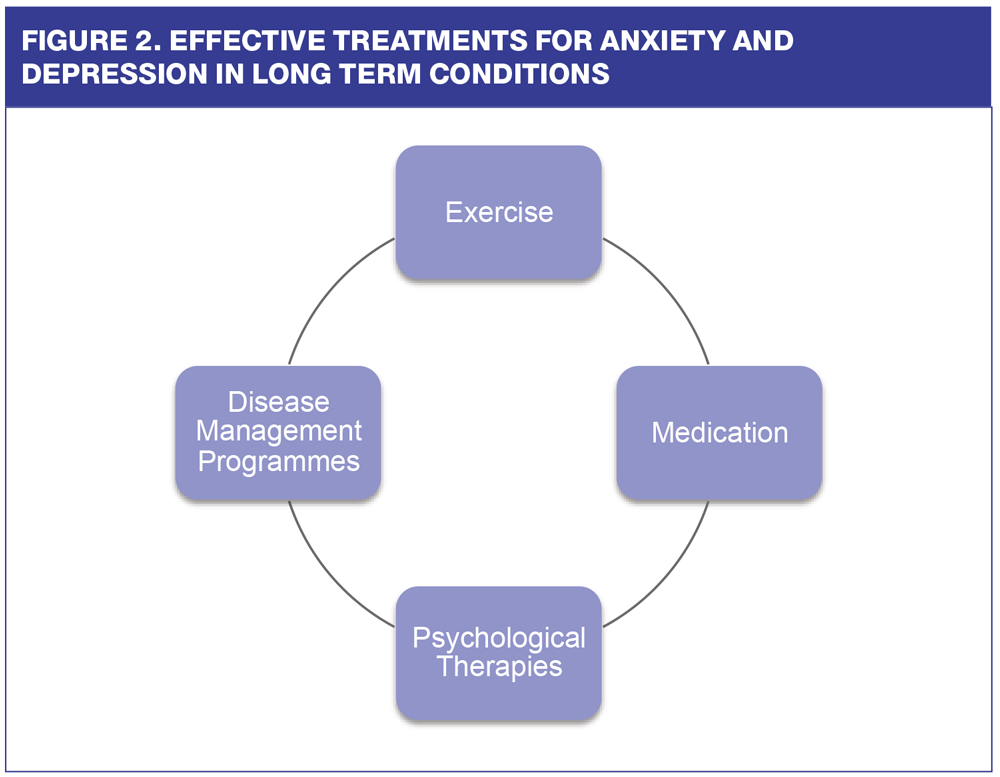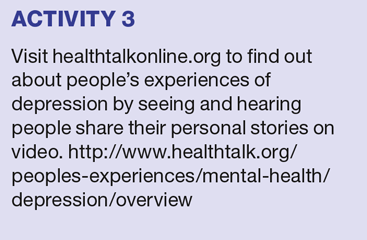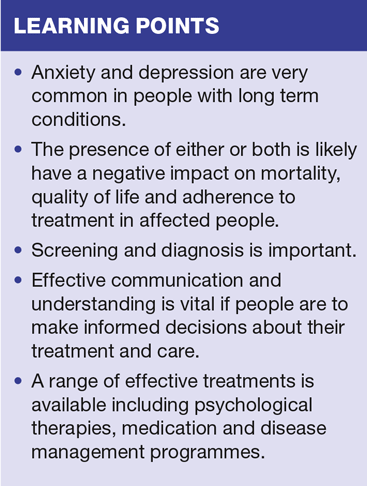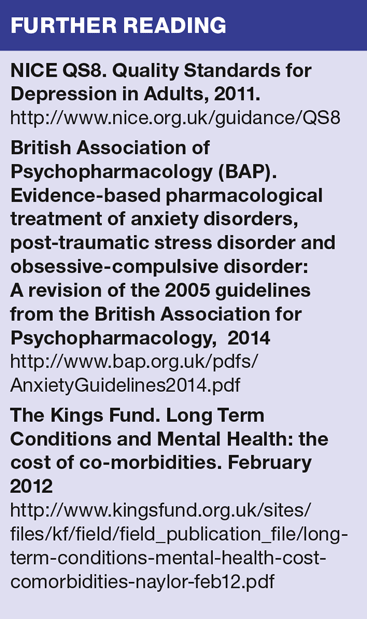Anxiety and depression: the hidden cost of long-term conditions
Joanne M Haws
Joanne M Haws
RN MSc
Independent Nurse Consultant in Cardiovascular Disease
Clinical Trainer, Education for Health
Where physical and psychological health issues co-exist, patients are likely to have poorer outcomes. Practice nurses are ideally placed to identify those at risk, and who may need treatment to improve both their quality of life and clinical outcomes
It is estimated that one in every six adults in the UK is affected by anxiety and/or depression and it is predicted that by 2020 depression will be the second most disabling condition in the world.1 Around 5% of the UK population has problems with anxiety and up to one in ten people will be troubled by mixed depression and anxiety. Depression can take many different forms with patients suffering a mix of physical, social and psychological problems.
Anxiety is a feeling we all experience when we are in a situation that feels threatening or difficult. For most of us the feeling will subside when we get used to the situation or leave it behind, but for some of us feelings of anxiety for no obvious reason are an everyday part of life.2 Anxiety is one of the most prevalent mental health problems in the UK and elsewhere, yet it is still under-reported, under-diagnosed and under-treated.3
Identifying people with these common mental health problems, and providing the most suitable treatment, can be a difficult and complex process for healthcare professionals. Many people with long-term physical health conditions also have problems with anxiety and/or depression.4 For example, a quarter of all people with severe chronic obstructive pulmonary disease (COPD) will also suffer depression and one in five people with mild COPD will be depressed at some stage.5 These co-morbidities can lead to significantly poorer health outcomes and reduced quality of life.6 (Figure 1) In the case of COPD the presence of depression has been proven to have a negative effect on adherence to treatment and smoking cessation attempts.5
Higher levels of depression than in the general population can also be seen in cardiovascular disease (CVD) and diabetes. This relationship is usually a graded one, in that the more severe the disease the more severe the depression is likely to be.7 Long-term conditions such as CVD and diabetes are also risk factors for cognitive impairment, including vascular dementia and Alzheimer’s disease. This risk can be further increased by the presence of depression.6
People suffering from chronic musculoskeletal problems are also commonly affected by depression. One in five people with chronic arthritis of the knees has been reported to suffer co-morbid depression. In addition, people living with HIV and with some cancers are more likely to become depressed, leading to poorer outcomes. Over all, evidence suggests that at least one third of all people with a long-term health condition also suffer from depression.6
HOW DOES IT WORK?
The relationship between physical and mental health is complex. Mechanisms underlying co-morbid long-term health conditions and mental health problems are likely to have biological, psychosocial, environmental and behavioural involvement.8 In addition, evidence suggests a two-way causal relationship, creating a ‘chicken and egg’ situation for those suffering from these conditions.
In the case of CVD, for example, two main theories behind the relationship between CVD and depression have been suggested. The first of these identifies depression as a marker of risk, producing an indirect effect via unhealthy behaviours. Common behavioural variables, including smoking, physical inactivity and having an unhealthy diet, are cited as the key factors linking depression and cardiovascular risk. In other words, if you are depressed you are more likely to smoke, be sedentary and eat unhealthy food; that is, to adopt the unhealthy behaviours that could lead to CVD.
The second theory is that physiological mechanisms behind depression initiate a cascade of events resulting in CVD in some individuals. One study declared depression to be a barrier to delivery of optimal cardiac care, finding that individuals with depressive symptoms are less likely to adhere to medication, follow lifestyle recommendations, self-manage their condition and attend for follow up.7 It is also recognised that, physiologically, there are shared mechanisms between CVD and depression.8 It has been noted that factors such as dysregulation of serotonin transmitters and a reduction in omega 3 fatty acids are common to both conditions.8 Similarly, a growing evidence base suggests that chronic stress has a direct impact on the cardiovascular, nervous and immune systems, leading to increased susceptibility to a range of diseases.9
SIGNS AND SYMPTOMS
Patients may not seek advice and support, or may not recognise signs and symptoms of anxiety or depression in themselves. (Box 1) Some may feel it is a ‘normal’ part of suffering with their health condition and are unlikely to ask for help. It is therefore important that every effort is made to identify patients who are suffering and offer interventions to reduce their health burden.
Some patients may report a feeling of low mood, or partners or families may observe it and raise their own concerns. Important symptoms include feelings of a lack of interest or pleasure in activities, or sleep disturbances. Impaired concentration or general fatigue is also common. Somatic symptoms are a common feature in anxiety and people often do not relate these to any psychological issues but become more anxious about potentially serious underlying health conditions,2 possibly resulting in increased demands on primary healthcare services.
SCREENING
Although screening for depression is a somewhat contentious issue, NICE recommends that, due to its common occurrence as a comorbidity, all practitioners caring for patients with long-term conditions should be alert to possible depression.10
A number of validated screening tools are available for use in clinical practice. These may be generic, such as the Hospital Anxiety and Depression Score, or disease specific, such as The Minnesota Living with Heart Failure Questionnaire. For general practice NICE recommends that, in order to identify those at risk, practitioners should firstly ask patients the following two questions:
1. During the last month, have you often been bothered by feeling down, depressed or hopeless?
2. During the last month, have you often been bothered by having little interest or pleasure in doing things?
If the patient answers ‘yes’ to either question further assessment is necessary, either by an appropriate practitioner or by using a validated assessment tool such as the Patient Health Questionnaire-9 (PHQ9).11 If further screening is positive the diagnosis should be discussed with the patient. Communication and understanding are extremely important in order for the patient to make informed choices about treatment options and to reduce further anxiety related to the diagnosis.5
In the case of anxiety, further tools, both brief (GAD-2) and more in-depth (GAD-7) are available to screen for Generalized Anxiety Disorder (GAD) (Box 2).12 GAD is a common disorder, of which the central feature is excessive worry about a number of different events, associated with heightened tension. NICE recommends that the diagnosis of GAD should be considered in people presenting with anxiety or significant worry, and in people who attend primary care frequently who:
- Have a chronic physical health problem, or
- Do not have a physical health problem but are seeking reassurance about somatic symptoms (particularly older people and people from minority ethnic groups), or
- Are repeatedly worrying about a wide range of different issues.13
TREATMENT OPTIONS
A number of treatment options are available in primary care and NICE recommends a stepped approach, with the patient involved in decision-making at every stage.10 In individuals with long-term conditions options may include psychological therapies, pharmacological therapies or a combined approach. Successful strategies are increasingly including disease-specific management programmes, often with an exercise component. (Figure 2)
Psychological therapies
Many primary healthcare practitioners feel that access to psychological or ‘talking’ therapies is inadequate. In recent years a national programme, known as the Improving Access to Psychological Therapies programme (IAPT), has been implemented to address this gap. IAPT is an NHS funded programme, approved by NICE, to support individuals with depression and anxiety disorders. It is available throughout the UK, has introduced new ways of offering psychological support and upskilled many healthcare professionals to deliver interventions.14
The most common approach used in Primary Care is Cognitive Behavioural Therapy or ‘CBT’. CBT helps individuals to change how they think (‘Cognitive’) and what they do (‘Behaviour’). CBT focuses on the ‘here and now’ problems and difficulties rather than focusing on the causes of distress or symptoms in the past. CBT can be offered on a face-to face basis or, more recently, as a computerised programme that patients can work through on their own or with support.
NICE recommends a stepped care approach to the treatment of depression and anxiety which advocates patient choice as the determinant of whether to try higher intensity psychological interventions or medication where initial talking therapies have not been successful.10,13
Medication
NICE recommends anti-depressant therapy for patients with depression and chronic illness where there has been a history of depression, longstanding depressive symptoms or depressive symptoms that have persisted despite previous therapy attempts.10
Although there is insufficient evidence to support the recommendation of any particular anti-depressant, the Selective Serotonin Reuptake Inhibitor (SSRI) class of drugs have a better overall safety and tolerability profile than older anti-depressants and are suitable to use in patients with common long-term conditions such as CVD and COPD.15 As with any pharmacological therapies patients should be counselled on initiation and adherence to the medication along with potential side effects and any monitoring requirements.
Rehabilitation
Disease-specific rehabilitation and management programmes can be very effective in improving the psychological wellbeing of patients, particularly after an acute event. For example, approximately 20% of patients will experience severe depression following a myocardial infarction (MI) and many more will suffer depressive symptoms, significantly affecting their recovery and mortality.16 The benefit of cardiac rehabilitation on the physical, emotional and social health of the individual is significant. Similar success has been seen with pulmonary rehabilitation.5
The British Association for Cardiovascular Prevention and Rehabilitation requires that psychological support, led by appropriately skilled, qualified and competent practitioners, should be a core component of all cardiac rehabilitation programmes. All patients should undergo assessment of anxiety and depression and other relevant psychosocial factors, including their perception of their illness and their readiness to change their lifestyle behaviours. It is recommended that services should help patients to become more aware of their mood, recognise stress and take steps to manage these feelings.17
Unfortunately less than half of eligible patients will attend a cardiac rehabilitation (CR) programme post-MI. NICE recommends that all patients are offered a programme of cardiac rehabilitation and efforts should be made to remove barriers to patients attending.18 It is worth asking patients who have had a recent MI if they are attending, or have attended, a programme and encouraging them to do so. The National Audit for Cardiac Rehabilitation highlights that the main reason for patients CR is ‘lack of interest or refusal,’19 and it would be worthwhile exploring this further with patients who have declined CR.
Exercise
Physical activity is a natural ‘mood-lifter’ and has an important role to play in the management of depression and anxiety. Its mood and functional capacity-increasing properties can be particularly useful in individuals with long-term conditions.7 Many areas of primary care can access exercise on prescription initiatives, in addition to disease management programmes. These should be offered to all eligible patients and their uptake encouraged.
LOOKING FOR DANGER SIGNS
For some people the burden of their physical health, combined with the burden of anxiety and/or depression, may feel like too much to bear. NICE recommends that patients presenting a risk to themselves should be referred urgently to specialist mental health services. Patients and their family or carer should be vigilant for mood changes, negativity and hopelessness, and suicidal ideation, and should contact their practitioner if concerned. This is particularly important during high-risk periods, such as starting or changing medication for depression and at times of increased personal stress.10
SUMMARY
GPs and practice nurses should work together with mental health services to ensure that patients receive the highest quality advice and access to care and appropriate services. They should refer to guidance from NICE for help in diagnosing depression.
Effective communication and understanding of the diagnosis are the first step in treating anxiety and depression and facilitating informed choice of treatments. A survey of primary healthcare professionals found that many, particularly practice nurses, did not feel confident discussing these issues with patients and that training had a positive impact on their confidence.20 Organisations and individuals should consider what options are available to facilitate professional development in this important clinical area that significantly impacts on mortality and quality of life in people with long-term conditions.
REFERENCES
1. Royal College of General Practitioners, Royal College of Psychiatrists. A joint statement by the RCGP and the RCPsych, 2008 www.rcpsych.ac.uk/mentalhealthinfoforall/problems/depression.patientsandantidepressants.aspx
2. Royal College of Psychiatrists. Anxiety, Panic and Phobias, 2013 http://www.rcpsych.ac.uk/healthadvice/problemsdisorders/anxiety,panic,phobias.aspx
3. Mental Health Foundation. Mental Health Statistics: Anxiety, 2014 http://www.mentalhealth.org.uk/help-information/mental-health-statistics/anxiety-statistics/?view=Standard
4. Robinson F. Impact of mental health on long-term conditions, February 2012
http://www.practicenurse.co.uk/index.php?p1=articles&p2=550
5. Wilson I. Depression in the patient with COPD. International Journal of Chronic Obstructive Pulmonary Disease 2006; 1(1): 61-4 http://www.ncbi.nlm.nih.gov/pmc/articles/PMC2706604/
6. The Kings Fund. Long Term Conditions and Mental Health: the cost of co-morbidities, February 2012
-naylor-feb12.pdf
7. Hare DL, Toukhsati SR, Johansson P, Jaarsma T. Depression and cardiovascular disease: a clinical review. European Heart Journal 2014; 35(21):1365-72.
8. Rumsfeld JS, Ho PM. Depression and Cardiovascular Disease: a call for recognition. Circulation 2005;111:250-235
9. Contrada RJ, Baum A. The Handbook of Stress Science: Biology, psychology and health. 2010 New York: Springer.
10. NICE CG91. Depression: Treatment and management of depression in adults, including adults with a chronic physical health problem, 2009. https://www.nice.org.uk/guidance/cg91
11. Kroenke K, Spitzer RL. The PHQ-9: new depression and diagnostic severity measure. Psychiatric Annals 2002; 32: 509-521
12. Kroenke K, Spitzer RL, Williams JB, et al. Anxiety disorders in primary care: prevalence, impairment, comorbidity, and detection. Annals of Internal Medicine 2007;146:317–25
13. NICE CG113. Generalised anxiety disorder and panic disorder (with or without agoraphobia) in adults: Management in primary, secondary and community care. NICE 2011 CG 113 https://www.nice.org.uk/guidance/cg113
14. Improving Access to Psychological Therapies. www.iapt.nhs.uk
15. MacGillivray S, Arroll B, Hatcher S et al. Efficacy and tolerability of selective serotonin reuptake inhibitors compared with tricyclic antidepressants in depression treated in primary care: systematic review and meta-analysis. British Medical Journal 2003;326:1014
http://dx.doi.org/10.1136/bmj.326.7397.1014
16. Williams, RB. Depression after heart attack. Circulation 2011; 123: e639-640
17. British Association for Cardiovascular Disease Prevention and Rehabilitation. Standards and Core Components for Cardiovascular Disease Prevention and Rehabilitation, 2012 http://www.bacpr.com/resources/46C_BACPR_Standards_and_Core_Components_2012.pdf
18. NICE CG172. MI – secondary prevention: Secondary prevention in primary and secondary care for patients following a myocardial infarction, 2013. http://www.nice.org.uk/guidance/CG172/
19.British Heart Foundation. National Audit of Cardiac Rehabilitation: Annual Statistical Report, 2014. http://www.cardiacrehabilitation.org.uk/docs/2014.pdf
20. Haws JM, Ramjeet, J, Gray RJ. A national survey of GP and nurse attitudes and beliefs towards depression after myocardial infarction. Journal of Clinical Nursing, 2011; 19 August 2011: 962-1067
Related articles
View all Articles

